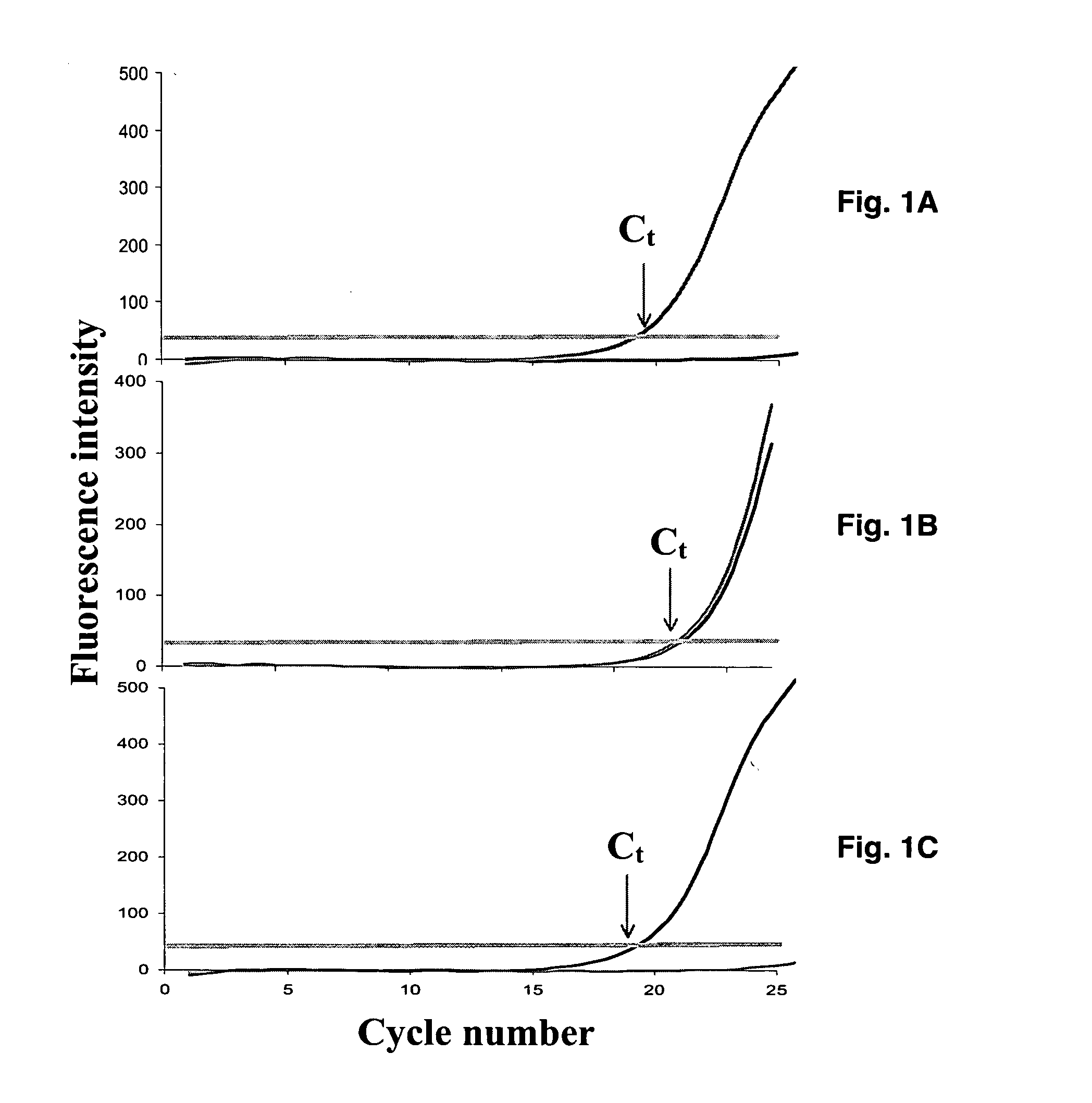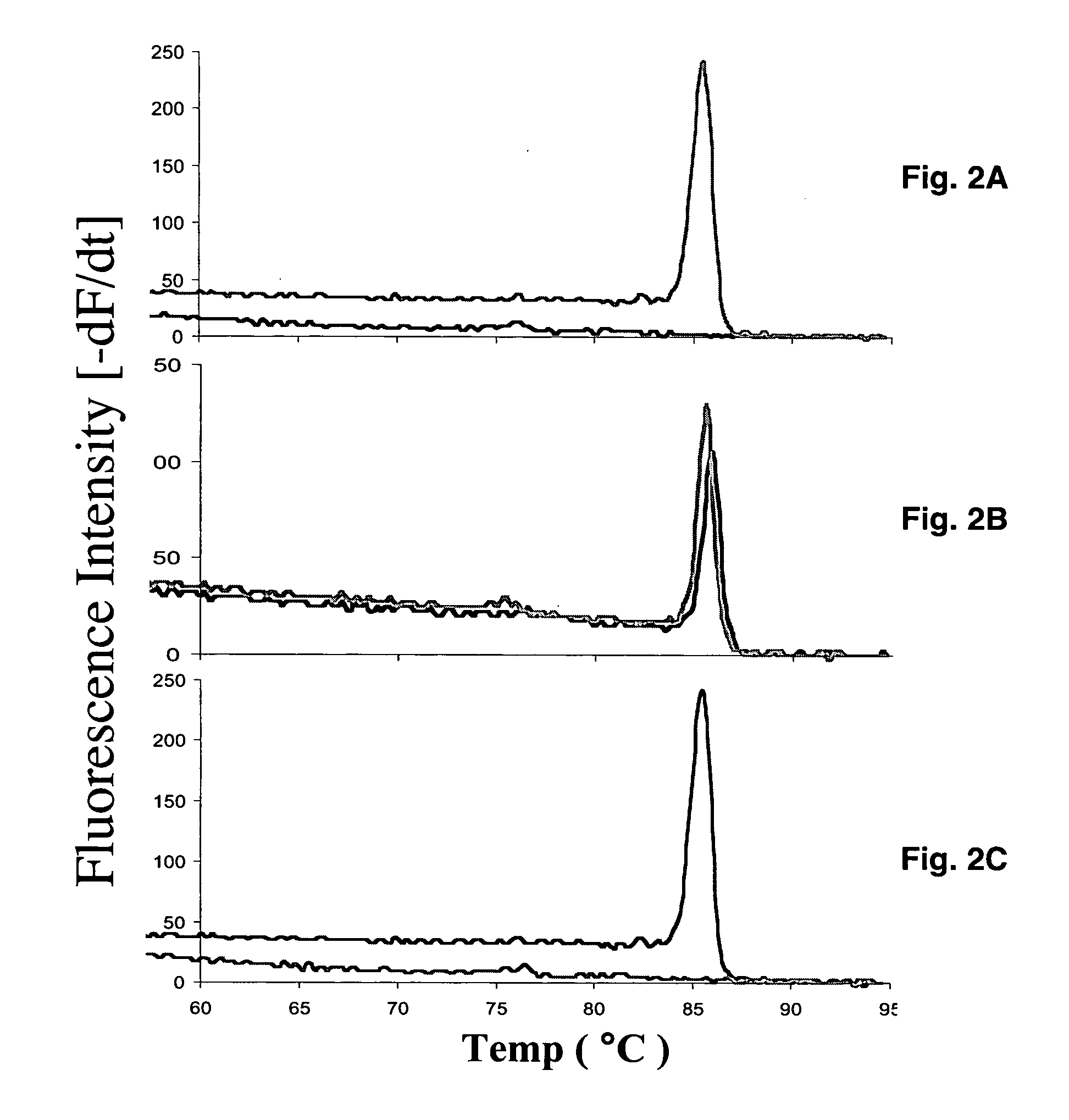Real-time polymerase chain reaction-based genotyping assay for beta2-adrenergic receptor single nucleotide polymorphism
a technology of adrenergic receptor and genotyping assay, which is applied in the field of single nucleotide polymorphism genotyping assay, can solve the problems of insufficient single base pair difference at the 3′ end of the primer, time-consuming and relatively expensive large-scale clinical and epidemiological studies, and achieves allelic discrimination. , the effect of preventing the amplification of non-matching primers
- Summary
- Abstract
- Description
- Claims
- Application Information
AI Technical Summary
Benefits of technology
Problems solved by technology
Method used
Image
Examples
example 1
β2-AR Single Nucleotide Polymorphisms Genotyping
[0052] The present example describes real-time PCR assays for the rapid detection of the β2-adrenergic receptor single nucleotide polymorphisms A46G and C79G. These methods can be readily applied to investigate the effect of the β2-adrenergic receptor polymorphic expression on pathogenesis, progression and / or pharmacotherapy of numerous respiratory and cardiovascular diseases including asthma, chronic obstructive pulmonary disease (COPD), and hypertension.
example 2
Primer Design
[0053] Discrimination between wild type and mutant alleles was achieved using PCR amplification of specific alleles modified to prevent non-Watson Crick base pairing (Okimoto & Dodgson, 1996; Sommer et al., 1992; Bottema et al., 1993; Newton et al., 1989). Since Taq DNA polymerase lacks 3′ to 5′ exonuclease activity, a primer with a mismatch in the 3′ terminal region with regard to the template will be amplified with reduced efficiency, allowing discrimination between matched and mismatched templates. Two forward primers and a common reverse primer were designed based on the nucleotide difference at the 3′ terminal base based upon the published β2-AR sequence (Sequence Accession No. M15169) using Primer3 program (Whitehead Institute for Biomedical Research, http: / / www. Genome. Wi.mit.edu / cgi-bin / primer / primer3_www.cgi).
[0054] Briefly, the allelic discrimination for A46G was achieved by designing two sense primers (46FW and 46FM) based on the nucleotide difference (A o...
example 3
Real-Time PCR Amplification
[0056] Genomic DNA was obtained for 10 Blacks and 10 Northern Europeans from the Human Genetic Cell Repository, sponsored by the National Institute of General Medical Sciences (http: / / locus.umdnj.edu / nigms). The use of Human Genetic Cell Repository samples was approved by the University of Tennessee Institutional Review Board. Polymorphisms were detected by PCR amplification of specific alleles (PASA) (Newton C. R. et al., 1989; Song P. et al., 2002; Gupta M. et al., 2004; Bottema C. D. et al., 1993; Okimoto R. et al., 1996) on a SmartCycler™ (Cepheid, Sunnyvale, Calif.) using SYBR™ Green I (Molecular Probes, Eugene, Oreg.), a nonspecific double-stranded DNA intercalating fluorescent dye.
[0057] Thus, to achieve allelic discrimination between wild type and mutant alleles, two physically separate PCR reactions containing either wild type specific primer (46FW) or mutant-specific primer (46FM) and a common primer (46R) was performed. All reactions were carr...
PUM
| Property | Measurement | Unit |
|---|---|---|
| Fraction | aaaaa | aaaaa |
| Fraction | aaaaa | aaaaa |
| Fraction | aaaaa | aaaaa |
Abstract
Description
Claims
Application Information
 Login to View More
Login to View More - R&D
- Intellectual Property
- Life Sciences
- Materials
- Tech Scout
- Unparalleled Data Quality
- Higher Quality Content
- 60% Fewer Hallucinations
Browse by: Latest US Patents, China's latest patents, Technical Efficacy Thesaurus, Application Domain, Technology Topic, Popular Technical Reports.
© 2025 PatSnap. All rights reserved.Legal|Privacy policy|Modern Slavery Act Transparency Statement|Sitemap|About US| Contact US: help@patsnap.com



